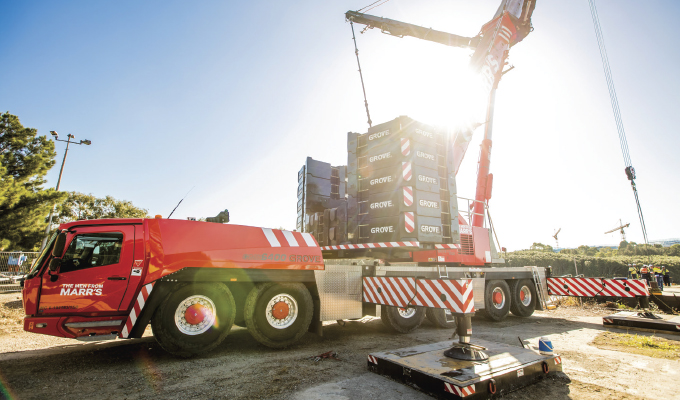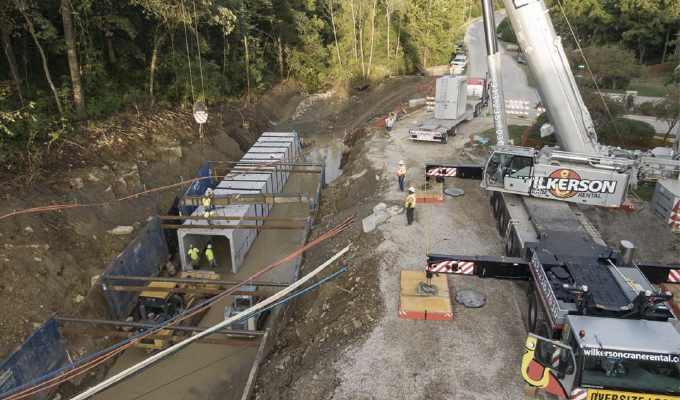Modern construction equipment generates far greater loads onto the ground (reaction forces) than many contractors realize. While reaction forces are often discussed in the context of cranes, the issue extends to any wheeled, tracked, or outrigger-enabled equipment used on job sites. Without proper site preparation and clear communication among stakeholders, inadequate ground conditions can lead to significant safety hazards and costly delays.
Reviewing the site and determining the appropriate placement and travel paths for heavy equipment is critical. Ultimately, the supporting surface must be able to withstand the pressures exerted by all types of heavy equipment, including cranes, aerial lifts, and concrete pump trucks. Failure to assess ground conditions appropriately can lead to equipment sinking, tipping, or shifting.
While the principles are similar regardless of the type of equipment, this article primarily focuses on mobile cranes with outriggers. According to research conducted by the Crane Inspection & Certification Bureau (CICB), up to 90 percent of crane-related accidents can be attributed to human error, with 54 percent of incidents due to improper outrigger use. This underscores the importance of ensuring that outriggers are properly deployed, ground conditions are properly assessed, and that adequate supporting materials are used to effectively distribute outrigger loads to the ground.
DEFINING RESPONSIBILITIES
One of the biggest challenges in managing ground stability is determining responsibility for site preparation. Often, the controlling entity is unaware of its obligation to ensure the ground can support equipment loads. OSHA 1926.1401 Subpart CC defines the controlling entity as the prime contractor, general contractor, or any legal entity that has responsibility for the construction of the project.
Under OSHA 1926.1402, the controlling entity is required to provide necessary ground preparations to meet safety requirements. This includes ensuring ground conditions are firm, properly drained, and graded to support the expected loads.
The assembly/disassembly director is responsible for directing the assembly and disassembly (erect/dismantle) of the load handling equipment (LHE). The engineer provides any required engineering support and documentation for the load handling activity.
The general contractor or construction manager is responsible for contractual requirements, including deliverables, and for ensuring that performance and safety requirements are established and implemented.
SELECTING PROPER SUPPORTING MATERIALS
Lift directors play a crucial role in this process by verifying that lift plans account for proper ground support and that necessary site preparations have been completed. A lift plan must include an assessment of site conditions, weather, work area, LHE foundation and support, utilities, support services, and ancillary equipment.
Both soft and hard ground can adversely affect the bearing area of supporting materials. Evaluating all conditions and variables aids in the selection of the right size, thickness, stiffness, and types of supporting materials used.
The essentials of providing stable ground and supporting materials include conducting a site assessment, using supporting materials with appropriate strength and stiffness properties, and then executing the application of supporting materials in the correct manner.
Site assessments and planning for supporting materials should include:
- Initial evaluations to determine whether the ground can support travel paths and equipment loads. In addition, the lift plan should include the maximum outrigger reaction forces for the equipment. Be sure not to forget about assist cranes or other equipment.
- Geotechnical investigations provide empirical data on soil mechanics, including compaction, drainage, and firmness. Soil boring and laboratory analysis help assess subsurface conditions, while Dynamic Cone Penetration (DCP) testing is used for surface and shallow-depth evaluations. With this information, the controlling entity can determine what the allowable ground bearing pressure is, which must then be communicated to the equipment provider.
- Use appropriate supporting materials, such as appropriately sized steel, wood, or synthetic composite materials, to distribute loads over a larger surface area and prevent ground failure. Selecting the proper type and size of supporting materials is critical to ensuring bearing pressures are reduced to a value below the failure threshold of the underlying ground. The effectiveness of supporting materials depends on factors such as material composition, strength, and stiffness.

FROM BEST PRACTICE TO STANDARD PRACTICE
The industry must shift from viewing ground stability as a best practice to making this the standard common practice. This starts with increased awareness of existing ASME standards, OSHA requirements, and guidelines from industry associations, such as the Specialized Carriers & Rigging Association.
Load distribution strategies should be integrated into everyday operations, ensuring all stakeholders understand their responsibilities, which helps to foster a culture of proactive site assessment.
Equipment operators must perform ongoing visual assessments of the ground conditions, ensuring that potential hazards are identified. Operators should watch for movement or deflection of supporting materials. These changes can lead to the crane going out of level, which impacts the lifting capacity. These issues can be addressed in several ways, but they are warning signs that the ground is being overloaded or the supporting materials need to be stiffer.
Controlling entities must understand their regulatory responsibility for site conditions and collaborate with all parties to ensure safety and efficiency. By fostering open communication and prioritizing ground stability as a standard operating procedure, the industry can minimize risks and optimize project performance.
about the author
Kris Koberg is CEO of DICA, a family-owned and operated company that specializes in building high-performance engineered outrigger pads, crane pads, and cribbing blocks. For more, visit www.dicausa.com.


